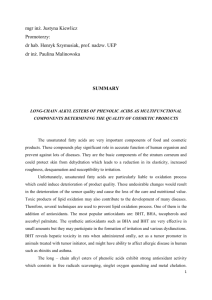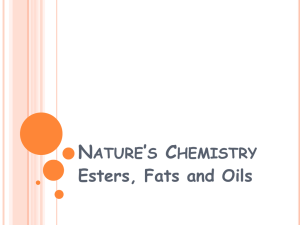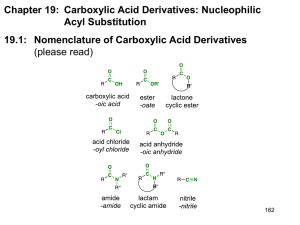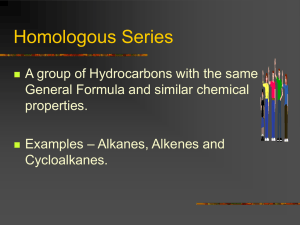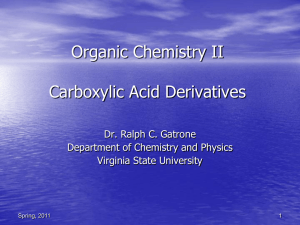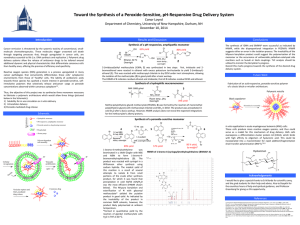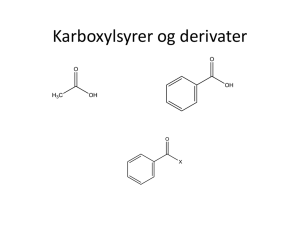APP_31232_sm_suppinfo
advertisement
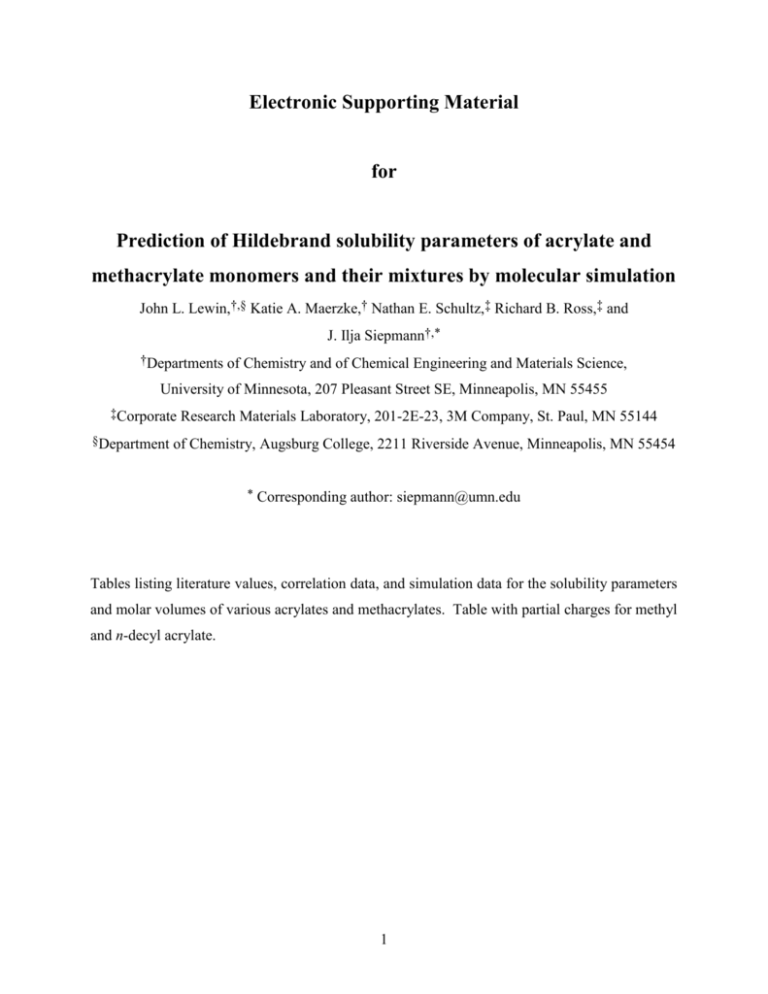
Electronic Supporting Material for Prediction of Hildebrand solubility parameters of acrylate and methacrylate monomers and their mixtures by molecular simulation John L. Lewin,†,§ Katie A. Maerzke,† Nathan E. Schultz,‡ Richard B. Ross,‡ and J. Ilja Siepmann†,* †Departments of Chemistry and of Chemical Engineering and Materials Science, University of Minnesota, 207 Pleasant Street SE, Minneapolis, MN 55455 ‡Corporate §Department Research Materials Laboratory, 201-2E-23, 3M Company, St. Paul, MN 55144 of Chemistry, Augsburg College, 2211 Riverside Avenue, Minneapolis, MN 55454 * Corresponding author: siepmann@umn.edu Tables listing literature values, correlation data, and simulation data for the solubility parameters and molar volumes of various acrylates and methacrylates. Table with partial charges for methyl and n-decyl acrylate. 1 Table S1. Hildebrand (total) solubility parameters of acrylate and methacrylate esters in units of (cal/cm3)1/2 taken directly from the literature. Polymer Hansen CRCd Literature a b c e HB HB Hoy 57th ed. Askadskii Average Std. Dev. Acrylate esters (linear alkyl unless noted) methyl 8.9 9.37 9.38 8.9 8.9 9.09 0.3 ethyl 8.6 8.76 8.81 8.6 8.4 8.63 0.2 butyl 8.8 8.55 8.63 8.4 8.9 8.66 0.2 hexyl 8.69 8.69 2-ethylhexyl 7.8 7.77 7.87 7.81 0.1 2-hydroxyethyl 12.07 12.07 Methacrylate esters (linear alkyl unless noted) methyl 8.8 8.76 9.23 8.8 8.7 ethyl 8.3 9.25 8.5 8.4 propyl 8.79 butyl 8.2 8.85 8.3 8.2 a ref. 6. b ref 13. c ref 9. d experimental values from ref. 37. e ref. 36. 2 8.86 8.61 8.79 8.39 0.2 0.4 0.3 Table S2. Hildebrand (total) solubility parameters of acrylate and methacrylate esters in units of (cal/cm3)1/2 calculated from normal boiling points (eqns. 2, 5, and 6) and refractive indices (eqn. 8). Rehberg & Yaws’ Polymer CRC refractive Fishera Gardonb HBc HBd 89th ed.e Askadskiif Eqn. 8g indexh Acrylate esters methyl ethyl propyl butyl pentyl hexyl heptyl octyl nonyl decyl 2-ethylhexyl 6-methylheptyl 2-hydroxyethyl 9.01 8.60 8.44 8.33 8.21 8.14 8.06 7.98 7.91 7.86 8.9 8.4 8.9 9.30 8.93 8.74 8.37 9.0 8.6 8.8 8.6 8.3 8.5 8.2 8.0 7.86 7.9 10.1k 11.56 8.63 8.66 8.71 8.77 8.81 8.86 8.88 8.92 8.94 8.96 8.93 8.93 9.05 1.4040 1.4068 1.4130 1.4190 1.4240 1.4285 1.4311 1.4360 1.4380 1.4400 1.4365i 1.437j 1.450j Methacrylate esters methyl 8.59 8.7 9.10 8.7 8.7 8.6 8.72 1.4142 ethyl 8.38 8.4 8.48 8.4 8.4 8.5 8.73 1.4147 propyl 8.26 8.40 8.3 8.3 8.77 1.4190 butyl 8.15 8.2 8.04 8.1 8.1 8.4 8.81 1.4240 pentyl 8.06 8.85 1.4284 l hexyl 8.00 7.4 8.89 1.4320m heptyl 7.92 8.91 1.4351m octyl 7.85 8.94 1.4374 nonyl 7.79 8.96 1.4401m decyl 7.74 8.3 8.97 1.4418 2-ethylhexyl 7.6 8.95 1.4390 2-hydroxyethyl 9.07 1.453j a calculated with eqns. 5 and 6; refs. 32 and 38. b reported as calculated with eqn. 6 in ref 8. c correlation data from ref. 14. d calculated with eqn. 6 from experimental normal boiling points in ref. 6. e calculated with eqn. 6 from experimental normal boiling points in ref. 33. f reported as calculated from eqn. 6 in ref. 36. g calculated with eqn. 8 using refractive indices (20 °C) from refs. 32, 38, 39 and 40. h refs. 32 and 38 unless noted otherwise. i ref. 39. j ref. 40, 25 °C. k molar volume determined at 23 °C. l molar volume determined at 25 °C; anomalously low normal b.p. of 162 °C. m calculated from data in reference 32. 3 Table S3. Experimental and correlation-based normal boiling points used to compute Hildebrand solubility parameters in Table S2. References as in Table S2. Rehberg & Polymer CRC Fishera HB 89th ed. Acrylate esters methyl ethyl propyl butyl pentyl hexyl heptyl octyl nonyl decyl 2-ethylhexyl 2-hydroxyethyl 80.0b 98 122 145 167 188 207 227 245 263 80.7 99.4 122 145 190 229 217 191 Methacrylate esters methyl 93 100 100.5 ethyl 117 118 117 propyl 140 140 141 butyl 162 161 160 pentyl 182 hexyl 203 162 heptyl 221 octyl 239 239.5 nonyl 257 decyl 274 327 2-ethylhexyl 218 2-hydroxyethyl 250 a calculated from eqn. 5 unless noted otherwise. b experimental value from ref. 38. 4 Table S4. Hildebrand (total) solubility parameters [in units (cal/cm3)1/2] of acrylate and methacrylate alkyl and hydroxy alkyl esters computed with the TraPPE-UA force field and the CED method [15]. Hildebrand (total) solubility parameter (cal/cm3)1/2 Lit. Rangea Lit. Avg. TraPPE std. err.b % err.c Dreiding Acrylate esters methyl 8.99.38 ethyl 8.48.81 propyl butyl 8.4–8.9 pentyl hexyl 8.69 heptyl octyl nonyl decyl 2-ethylhexyl 7.77–7.87 6-methylheptyl 2-hydroxyethyl 12.07 MUPEd 9.09 8.63 8.66 8.69 7.81 12.07 9.075 8.649 8.478 8.427 8.364 8.354 8.324 8.303 8.314 8.259 8.057 8.195 12.047 0.009 0.017 0.006 0.011 0.014 0.014 0.014 0.019 0.018 0.017 0.009 0.016 0.034 –0.2 0.2 –2.6 –3.9 3.1 –0.2 1.7 10.51 10.67 10.19 9.40 9.32 9.25 8.96 8.79 8.70 8.54 8.56 8.94 12.92 % err.c 15.6 23.5 8.6 6.4 9.5 7.0 11.8 Methacrylate esters methyl 8.79.23 8.86 8.836 0.008 –0.3 9.82 10.9 ethyl 8.39.25 8.61 8.499 0.020 –1.3 9.77 13.5 propyl 8.79 8.79 8.303 0.011 –5.6 9.34 6.2 butyl 8.28.85 8.39 8.255 0.017 –1.6 9.10 8.5 pentyl 8.207 0.018 8.88 hexyl 8.200 0.016 8.71 heptyl 8.180 0.019 8.41 octyl 8.174 0.015 8.47 nonyl 8.170 0.015 8.40 decyl 8.163 0.012 8.37 2-hydroxyethyl 11.399 0.026 11.92 d MUPE 2.2 9.8 a where no range is listed, no data were available. b standard error of the mean for TraPPE-UA simulations. c relative to the average of experimental values in the “Lit. Avg.” column. d mean unsigned percent error. 5 Table S5. Molar volumes of acrylate and methacrylate esters in units of (cm3/mol), determined from experimental 20 °C (293 K) densities unless noted otherwise. Original sources as in Table S1. Rehberg & Yaws Polymer Fisher HBa HB Acrylate esters (linear alkyl unless noted) methyl 90.3 90.714 90.1 ethyl 108.4 109.086 108.4 propyl 125.7 126.898 125.7 butyl 142.4 143.353 143.4 pentyl 159.7 159.4 hexyl 175.9 175.9 heptyl 192.5 192.5 octyl 209.2 209.2 nonyl 225.7 226.6 c decyl 241.8 241.8 d 2-ethylhexyl 208.2 209.414 208.0 2-hydroxyethyl 115.214 114.9 6-methylheptyl 209.4 Hansen HB CRC Barton & Hoyb 90.3 108.8 90.3 108.4 90.6 109.4 143.8 144.0 143.2 177.9 176.9 209.2 208.2 114.9 209.4e 114.9f 209.2 105.0g Avg. Expt. 90.4 108.8 126.1 143.4 159.6 176.7 192.5 209.2 226.2 241.8 208.7 113.0 209.4 Methacrylate esters (linear alkyl unless noted) methyl 106.1 106.828 107.0 106.1 106.8 107.7 106.7 ethyl 125.0 125.712 124.5 125.8 125.0 125.2 propyl 142.1 142.862 142.1 158.8 142.1 145.6 butyl 159.1 159.663 159.1 159.4 159.1 159.3 pentyl 175.7 175.7 h e hexyl 192.2 192.4 193.5 192.7 h heptyl 208.7 208.7 octyl 225.2 225.2 h i nonyl 241.7 193.2 241.7 decyl 258.2 258.7 258.4 2-ethylhexyl 224.1 224.1 225.3 224.5 2-hydroxyethyl 120.6e 120.6 a group additive data for 25 °C from ref. 14. b ref. 5. c used average of two similar density values. d ref. 39. e 25 °C. f 23 °C. g BASF MSDS. h determined from calculated density data in ref. 32. i anomalously high density of 1.099 g/mL. 6 Table S6. Molar volume acrylate and methacrylate alkyl and hydroxy alkyl esters (in units of cm3/mol) computed with the TraPPE-UA force field and the CED method [15]. Avg. Acrylate esters methyl ethyl propyl butyl pentyl hexyl heptyl octyl nonyl decyl 2-ethylhexyl 6-methylheptyl 2-hydroxyethyl MUPEc Expt.a 90.4 108.8 126.1 143.4 159.6 176.7 192.5 209.2 226.2 241.8 208.7 209.4 113.0 Methacrylate esters methyl 106.7 ethyl 125.2 propyl 145.6 butyl 159.3 pentyl 175.7 hexyl 192.7 heptyl 208.7 octyl 225.2 nonyl 241.7d decyl 258.4 2-hydroxyethyl 120.6 MUPEc molar volume (cm3/mol) TraPPE % err.b Dreiding % err.b 92.39 110.72 127.89 144.41 160.77 177.08 193.39 209.82 225.75 242.59 209.06 210.01 108.50 2.2 1.8 1.4 0.7 0.8 0.2 0.5 0.3 –0.2 0.3 0.2 0.3 –4.0 1.0 91.6 105.4 125.4 144.0 163.4 179.6 200.3 219.4 236.1 252.8 219.4 230.6 112.7 1.3 –3.1 –0.5 0.4 2.4 1.6 4.1 4.9 4.4 4.5 5.1 10.1 –0.3 3.3 108.73 127.38 144.58 161.10 177.36 193.96 210.42 226.33 242.89 259.25 124.79 1.9 1.8 –0.7 1.1 0.9 0.7 0.8 0.5 0.5 0.3 3.5 1.2 107.7 125.4 145.6 161.6 183.8 200.3 222.0 236.1 255.8 269.5 131.5 0.9 0.2 0.1 1.5 4.6 4.0 6.4 4.8 5.8 4.3 9.0 3.8 a values from Table S5. b relative to the average of experimental values in leftmost column. c mean unsigned percent error. d ref. 32 value only. 7 Figure S1. Atom numbering scheme for methyl acrylate and decyl acrylate. See also Table S7. Table S7. Comparison of united atom TraPPE and Dreiding ESP partial charges on methyl acrylate and decyl acrylate in units of e. See Figure S1 for atom numbering. atom C1 C2 C3 O4 O5 C6 methyl acrylate TraPPE Dreiding 0.00 0.120 0.00 –0.263 0.40 0.994 –0.40 –0.619 –0.25 –0.480 0.25 0.247 atom C1 C2 C3 O4 O5 C6 C7 C8 C9 C10 C11 C12 C13 C14 C15 decyl acrylate TraPPE Dreiding 0.00 0.098 0.00 –0.231 0.40 1.042 –0.40 –0.650 –0.25 –0.623 0.25 0.346 0.00 0.041 0.00 –0.067 0.00 0.029 0.00 0.019 0.00 0.011 0.00 –0.046 0.00 0.009 0.00 0.124 0.00 –0.103 8

